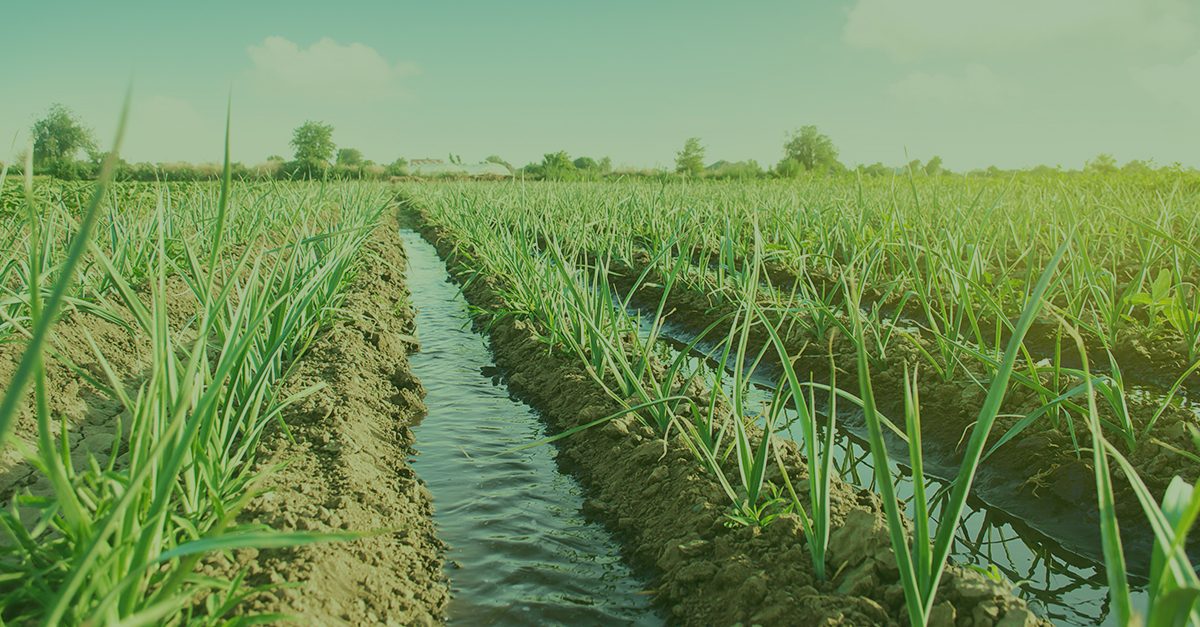Exploring agriculture can present one of the best indirect methods to accurately price water, a perpetually mispriced commodity.
“Man—despite his artistic pretensions, his sophistication and his many accomplishments—owes his existence to a six-inch layer of topsoil and the fact that it rains.” – Unknown
Key Points
- Water is one of the most mispriced commodities, as the natural resource lacks both a global market and any effective transportation method that would allow it to move from an area of abundance to one of scarcity.
- Currently, the agriculture sector is the largest consumer of available freshwater globally, accounting for 70% of all freshwater withdrawals.
- We believe that a deep dive into agriculture can yield important insights into how to accurately price water.
Nothing is as essential as food and water. Similar to the role of fossil fuels in the agriculture sector, people often underestimate how vital water is to agriculture and, likewise, our food system. The farming process can be broken down into five essential components: sunshine, soil, fertilizers, labor and water. A plant requires water for photosynthesis, transpiration (the most substantial use of water for a plant) and the maintenance of its cell structure. New farming methods and technological advances have reduced water usage, but much like sunshine, there is no replacement for water as a vital ingredient for healthy plant growth. We believe that a deep dive into agriculture can yield important insights into how to accurately price this essential commodity.
How Much Water Does Agriculture and Food Use?
Currently, the agriculture sector is the largest consumer of available freshwater globally, accounting for 70% of all freshwater withdrawals, including watercourses and groundwater.[1] The agricultural complex consumes 2 quadrillion gallons of water annually, an amount that could cover the entire United States with 2 feet of water.[2] This consumption has more tripled over the last 50 years, and by 2050, irrigation demand is expected to increase by roughly 20% globally.[3]
Examining the origins of the food on our dinner tables can further illustrate the vast and substantial use of water in agriculture. For instance, one hamburger requires a staggering 660 gallons of water to produce.[4] Animal husbandry is one of the most water-intensive industrial activities, as the production of animal feed soaks up 30% of agriculture’s water consumption. It is widely acknowledged that farming animal protein is exceptionally water-intensive, with 1,451 liters of water required to produce 1 kilogram of beef and 660 liters of water required to produce 1 kilogram of chicken. Unfortunately, this high water consumption does not abate as populations shift from red meat to heathier alternatives. Seafood (particularly farmed fish) requires 3,691 liters of water to produce 1 kilogram of food, while nuts demand a whopping 4,143 liters. Even a common staple grain such as rice requires more water per kilogram (2,248 liters) than the average animal protein. Alternative sources of plant-based proteins like peas and wheat provide some reprieve but still require 397 and 648 liters, respectively.[5]
The Tragic Misvaluation of Water
Water is one of the most mispriced commodities, as the natural resource lacks both a global market and any effective transportation method, which would allow it to move from an area of abundance to one of scarcity. We believe that exploring agriculture presents one of the best indirect methods to correctly price water.
To illustrate this belief, we can consider the transportation of both water and soybeans. Producing a pound of soybeans requires 240 gallons of water. If, hypothetically, we convert a very large crude carrier (VLCC) oil tanker to carry either water or grain, the tanker could volumetrically carry roughly 105 million gallons, or about 870 million pounds, of water (assuming the VLCC has capacity to carry 2.5 million barrels with 42 gallons per barrel). If the same tanker carried 870 million pounds of soybean, it would be the equivalent to carrying 208 billion gallons of water, as this is the amount required to grow that crop. In reality, there are numerous nuances that could alter this illustrative math. However, the point remains the same: agriculture is one of the most effective forms of transporting water from a tonnage and volumetric perspective.
As previously noted, water lacks an active market with efficient price discovery, perpetuating discrepancies in water pricing. While water continues to be mispriced on both regional and global levels, the globalized agricultural and food complex is one of the largest and most liquid financial markets. Instant, minute-by-minute quotes on a bushel of soybean are readily available, and yet static, localized water prices do not effectively reflect supply or demand. For instance, a drought in Australia will rarely affect water prices beyond the regional locality; however, that same phenomenon is likely to cause price reverberations in the global wheat market. With this reasoning in mind, we propose the following outlook: the value of water should continue to increase in the coming decades, and we believe higher agriculture prices could be one of the best ways to capitalize on the trend.
Water Competition, Scarcity and Volatility
The term “water scarcity” is a misnomer. Water is not actually scarce, but rather it is often sparse in places where the demand is high and abundant in locations where demand is low. While the entire global supply of water is fairly constant, the rising need for the natural resource is troubling. A rapidly growing population and more water-intensive consumption patterns equate to a continued rise in water requirements. Since 1900, the demand for freshwater withdrawals for agriculture, industry and municipal uses has grown nearly six-fold.[6] While we believe the rate of this demand increase should ease through enhanced technologies and water conservation efforts, global population growth and overall better standards of living require increased water usage. Even if we excluded water-intensive activities linked to the energy and industrials industries, the amount of water required to maintain the population’s basic human needs, such as hygiene, is set to grow meaningfully. By 2050, the world’s population is estimated to rise by 2 billion people.[7] If this expectation proves to be accurate, the annual increase in water usage for basic health and hygiene practices could easily exceed 10 billion gallons (The World Health Organization estimates that 50 to 100 liters of water are needed per person per day to meet basic needs.).[8]
Conclusion
As we look ahead, we plan to further explore the effects of climate change on agriculture and water consumption. The current takeaway is that climate fluctuations could lead to extreme water volatility and thus push the cost of food production higher and higher. Significant droughts in major agricultural areas such as Latin America and the United States have already affected production and diminished groundwater reserves. It is important to note though that a lack of water is not the only condition that could destabilize global agriculture. Arable growing conditions could be further threatened by overflowing water caused by floods and storms. Climate change is a tale of both extremes, and we plan to closely monitor its effects on water in the agriculture sector, and likewise our food system.
[1] Source: The World Bank. (2022, October 5). Water in Agriculture. https://www.worldbank.org/en/topic/water-in-agriculture
[2] Source: Balsom, P. (2020, September 28). Water Usage in the Agricultural Industry. High Tide Technologies. https://htt.io/water-usage-in-the-agricultural-industry/
[3] Source: IAASTD Report. (2009). Agriculture at a Crossroads: Findings and Recommendations for Future Farming. Retrieved October 12, 2022, from https://www.globalagriculture.org/report-topics/water.html
[4] Source: GRACE Communications Foundation. (2019, December 2020) What is the Water Footprint of…? https://www.watercalculator.org/footprint/what-is-the-water-footprint-of/
[5] Source: Ritchie, H., & Roser, M. (2020). Environmental Impacts of Food Production. Our World in Data. Retrieved October 12, 2022, from https://ourworldindata.org/environmental-impacts-of-food
[6] Source: Ritchie, H., & Roser, M. (2017). Water Use and Stress. Our World in Data. Retrieved October 12, 2022, from https://ourworldindata.org/water-use-stress
[7] Source: United Nations Department of Economic and Social Affairs. (n.d.). https://www.un.org/en/desa/world-population-projected-reach-98-billion-2050-and-112-billion-2100
[8] Source: UN-Water Decade Programme on Advocacy and Communication and Water Supply and Sanitation Collaborative Council. (n.d.). The Human Right to Water and Sanitation. https://www.un.org/waterforlifedecade/pdf/human_right_to_water_and_sanitation_media_brief.pdf
PAST PERFORMANCE IS NOT NECESSARILY INDICATIVE OF FUTURE RESULTS. Any reference to a specific security, country or sector should not be construed as a recommendation to buy or sell this security, country or sector. Please note that strategy holdings and positioning are subject to change without notice. For additional Important Information, click on the link below.
Important information
For Institutional Clients Only. Issued by Newton Investment Management North America LLC ("NIMNA" or the "Firm"). NIMNA is a registered investment adviser with the US Securities and Exchange Commission ("SEC") and subsidiary of The Bank of New York Mellon Corporation ("BNY"). The Firm was established in 2021, comprised of equity and multi-asset teams from an affiliate, Mellon Investments Corporation. The Firm is part of the group of affiliated companies that individually or collectively provide investment advisory services under the brand "Newton" or "Newton Investment Management". Newton currently includes NIMNA and Newton Investment Management Ltd ("NIM") and Newton Investment Management Japan Limited ("NIMJ").
Material in this publication is for general information only. The opinions expressed in this document are those of Newton and should not be construed as investment advice or recommendations for any purchase or sale of any specific security or commodity. Certain information contained herein is based on outside sources believed to be reliable, but its accuracy is not guaranteed.
Statements are current as of the date of the material only. Any forward-looking statements speak only as of the date they are made, and are subject to numerous assumptions, risks, and uncertainties, which change over time. Actual results could differ materially from those anticipated in forward-looking statements. No investment strategy or risk management technique can guarantee returns or eliminate risk in any market environment and past performance is no indication of future performance.
Information about the indices shown here is provided to allow for comparison of the performance of the strategy to that of certain well-known and widely recognized indices. There is no representation that such index is an appropriate benchmark for such comparison.
This material (or any portion thereof) may not be copied or distributed without Newton’s prior written approval.





